Abstract
Background: Fishing is a risky occupation as injuries and fatalities in fishing vessels are quite common. This paper investigates the pattern of injuries aboard fishing vessels in Denmark to get a better understanding of areas where further action is needed to reduce the number of injuries and fatalities in Danish fishing vessels. Materials and methods: Data for this study, extracted from the Danish Fishermen’s Occupational Health Service’s database (in the period 1998–2012) and the Danish Maritime Authority’s accident report from 2013 to 2016, include 1840 injuries in Danish fisheries. Result: The results showed decreased injuries in the study period from 45 injuries and deaths per 1000 fishermen reported to the authorities to 12 injuries and deaths per 1000 fishermen in 2016: 2.1% (n = 39) of all reported injuries in the study period resulted in the death of a fisherman and the remaining injuries resulted in sick leave of more than one day; 52.5% (n = 600) of reported injuries involved fishermen who have less than one year’s experience of employment; 29% (n = 407) of injuries took place between 12:00 and 16:00, and the second largest number of injuries, 23.3% (n = 324), took place between 8:00 and 12:00. The incident rate of slip/fall injuries has decreased from 10.06 per 1000 fishermen in 1998 to 3.84 in 2016. The incidence rate of injuries caused by crushing also decreased, from 9.32 accidents per 1000 fishermen in 1998 to 2.56 in 2016. Most of the injuries, 74.5% (n = 1307), happened on the deck of the vessel. Sprain/strain was among the most common injuries (34.2%; n = 538) followed by fracture (24.8%; n = 391). Conclusion: This study indicated that the number of injuries had been gradually decreasing in Danish commercial fishing vessels in the period from 1998 to 2016. The rate of injuries had been declining due to several initiatives such as the establishment of The Danish Fishermen’s Occupational Health Services, training, safety campaigns, technological improvement and structural changes in fisheries management. However, there are still places for improvement.
1. Introduction
Fishing is one of the oldest human professions. At present, about 260 million people are engaged in fishing activities across the globe [1]. Offshore fishing is considered a risky profession in terms of not only economic outcome but also occupational injury and fatality. In fact, commercial fisheries are widely recognized as one of the most dangerous occupations, with increased rates of mortality [2], morbidity [3], fatal occupational accidents [4] and injuries [5] compared to land-based occupations. Comparatively longer working hours than several other professions onshore in Denmark, extreme weather conditions and working with heavy machinery contribute to a high mortality and injury rate in the fishing profession [6].
Modern fishing vessels have over the years become increasingly complex industrial settings with numerous technological aids and machinery [7]. Despite the introduction of these technological aids, the job as a fisherman continues to be physically demanding, with frequent manual handling of heavy equipment on wet, slippery decks and in moving surroundings. In addition, fishermen are exposed to whole-body vibrations and harsh environmental conditions (e.g., wind, cold, heat) which, in combination with the other exposures, may contribute to an unhealthy work environment, leading to an increased risk of negative health outcomes such as injuries [8].
Denmark is one of the key players in the capture fisheries (sector in EU, although the Danish fishing fleet has experienced a major transition over recent years with a pronounced decrease in both number of vessels and active fishermen [9]. There are about 2700 fishing vessels in Denmark [10]. According to the Danish Agrifish Agency [10], there are about 8000 people employed in the Danish fishing industry, which generated an income of approximately 3.0 billion Danish Kroner (€0.4 billion). In Denmark, over 95% of the enterprises own a single vessel while the rest have between two and five vessels [11]. Around 80% of the vessels in Denmark are less than 12 m long and the majority use (set) gillnet, while the remaining 20% of the vessels are longer than 24 m and usually use bottom otter trawls (13%), boat dredges (3%) and other kinds of fishing gear [11].
The Danish studies had indicated that the risk of accidents among the Danish fishermen was as much as 1.41 injuries per 1000 man-days at sea [12]. Various technological aids have been introduced to reduce the physical injuries in Danish fisheries like skid proof deck, and various systems to reduce heavy lifting, both on the deck and in the cargo bay. The Danish Fishermen’s Occupational Health Services (DFOHS) was established in 1993 with the aim to support fishermen in improving safety and preventing occupational injuries. During the past years, DFOHS has provided safety campaigns and teaching materials, tested new equipment, introduced new legislation, and held counselling meetings about regulation and technical issues. The DFOHS also supports the local harbor safety committees in their work and organizes meetings for all harbor committees once a year to share knowledge and legislation [13]. Therefore, with establishment of the DFOHS, the focus on safety in the fishing industry has become more intense, and the fishermen are obligated to report the injuries to the Danish Maritime Authority (DMA), and they are also obligated to participate in mandatory safety training.
Though the technological aids and various programs from the DFOHS have been introduced to reduce the physical injuries in Danish fisheries, accidents in fishing vessels are still taking place. Therefore, the aim of this paper is to investigate the rate and pattern of injuries that occurred in the fishing vessels in Denmark in the period from 1998 to 2012. Furthermore, this study also intends to depict important characteristics of the reported injuries to get a better understanding of which areas of the Danish fisheries require attention to further reduce the number of occupational injuries in the fishing vessels.
2. Materials and Methods
This study is based on data extracted from the Danish Fishermen’s Occupational Health Service’s database on accidents in Danish fisheries. The database from DFOHS includes all accidents reported to a local safety organization or reported on claim forms to the Danish Maritime Authority (DMA). The DFOHS has gathered information about injuries systematically since 1998. The database contains information about the type of accident, the course of events, where it happened and how long the injured person was expected to be away from work.
The data was collected in two steps, the first part covering the period from 1998 to 2012 was collected in 2013 in connection with the project “Safety culture in the fishing industry” supported by the European Fisheries Fund [13]. The data covering the period from 2013 to 2016 was collected in 2017. The project “Safety culture in the fishing industry” contains also interviews with fishermen, but this study focuses on the quantitative part [13].
According to the Danish regulation, chapter X, paragraph A, “nobody may perform commercial work on board a fishing vessel, irrespective of its size, without having a valid health certificate as well as having completed a basic course for ship’s assistants or an approved safety course for fishermen approved by the Danish Maritime Authority. According to Danish legislation, the skipper of any fishing vessel is obligated to report occupational accidents and poisoning incidents that have occurred on board to the Danish Maritime Authority (DMA) if the accident or the poisoning has resulted in (i) death; (ii) inability to work for one day or more in addition to the day of the injury (Lost time accident—LTA); or (iii) the injured person not being able to carry out his usual work for one day or more in addition to the day of the injury (Restricted work accident—RWA)” [14].
The reporting duty of accidents to DMA does not include accidents connected to loading and landing in the Danish harbors, dockyards, or on offshore installations. Work-related diseases and dental injuries are usually reported by physicians or dentists respectively in another reporting system and are not reported to DMA. The purpose of the reporting system is to ensure that the proper identification can be provided for following insurance issues—but also to give rise to prevention of similar accidents in the future.
In total, this study covered 1840 accidents in the period 1998–2016. However, in some tables, the number varies due to missing information on specific items. The inclusions and exclusions criteria are presented in Figure 1.
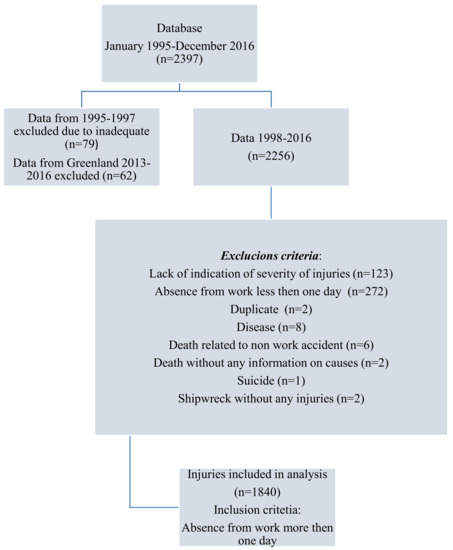
Figure 1.
Flow chart illustrating the injuries chosen for analysis.
The analysis focuses on work-related injuries, which occurred during fishing activities. However, in the database there was also information about injuries connected to shipwrecks. However, these injuries were not included in work-related injuries. The preventive measures needed to avoid incidents such as capsizing, collisions, fires and explosions are significantly different from those needed to prevent work-related injuries.
The information about the total population of fishermen, which is used to calculate incident rates (i.e., number of injuries per 1000 fishermen), is obtained from the Danish Agrifish Agency [10]. The calculations of incident rates for injury are based on the equations from McGuinness et al. [15]. The study population includes both full-time and part-time fishermen:
Incident rate = NA/MY * 1000
Man-year (MY) calculations include full-time and part-time fishers, where Nff is the number of full-time fishermen and Npf is the number of part-time fishermen. Man-year calculation pays regard to the fact that fishermen do not work all days during a calendar year. Incident rates are calculated by dividing the number of accidents (NA) by MY and multiplied by 1000 (In Table 1 the man-years for the entire study period are shown).
MY = 0.9 * Nff + 0.45 * Npf

Table 1.
Man-years in the Danish fishing fleet (1998–2016).
This study mostly followed the descriptive statistics and Chi-squared tests.
3. Results
3.1. General Results for the Danish Fishing Fleet
There were 1840 injuries reported to the Danish Maritime Authority or to local safety organizations within the study period that were suitable for further analyses in the present study. Overall incident rate for the study period is 25 accidents per 1000 fisherman.
Figure 2 shows the incident rates for all reported work-related injuries and deaths per 1000 fishermen in the Danish commercial fishing fleet in the period 1998–2016. There seems to be a convincing descending trend in the number of injuries and deaths in Danish commercial fisheries during the study period. In year 2000, there were more than 45 injuries and deaths per 1000 fishermen reported to the authorities. In year 2016, the number had decreased to 12 injuries and deaths per 1000 fishermen. Of all reported injuries in the study period, 2.2% (n = 37) resulted in the death of a Danish fisherman. The remaining incidents (97.8%) resulted in sick leave of more than one day. Figure 2 shows an increase in incident rate from 1998 to 2000; however, there is uncertainty about the numbers from 1998 to 1999. As mentioned in the introduction, the DFOHS established their database in 1998 and, at that time, there was not a strong tradition for reporting injuries to authorities, but that attitude has changed over the years [13]. During the whole period, there were no changes to the legislation, which could influence the reporting frequency; so, the decrease of injuries could be seen as an effect of the industrial development, the establishment of DFOHS and an intense focus on safety from authorities and other stakeholders.
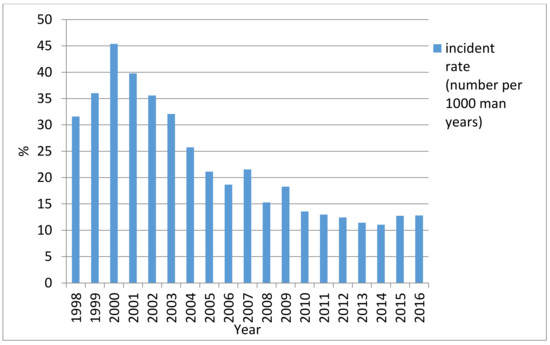
Figure 2.
Incident rate of fatal and non-fatal injuries per 1000 fishermen in the Danish fishing fleet in the period from 1998 to 2016.
3.2. Reported Injuries Related to Shipwreck
Further analyses of the reported injuries that resulted in death revealed that 41% (n = 16) of all death cases happened as a result of shipwreck (Table 2). During the total study period, there were reported shipwrecks on 33 vessels involving a total of 56 persons. More than 1 in 4 of the fishermen included in this study who were involved in a reported shipwreck was killed. A comparison of the frequency of fatal accidents caused by shipwreck with fatal accidents during work showed that most of the fishermen died in shipwreck incidents.

Table 2.
Reported shipwrecks, work-related injuries, and their consequences in the period 1998–2016.
The data showed that collision (40%) with other boats is the main reason for shipwreck (Figure 3). Furthermore, the frequency of shipwrecks and occupational accidents are much higher in fishing trawlers than any other type of fishing vessels (Figure 4); however, the approximate percentage of trawlers in the Danish fishing fleet was around 20% (n = 13) during the study period.
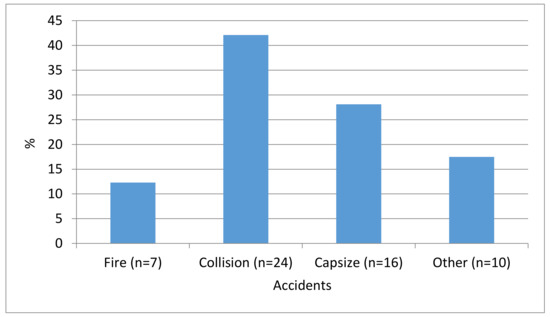
Figure 3.
Reasons for shipwreck in the period 1998–2016.
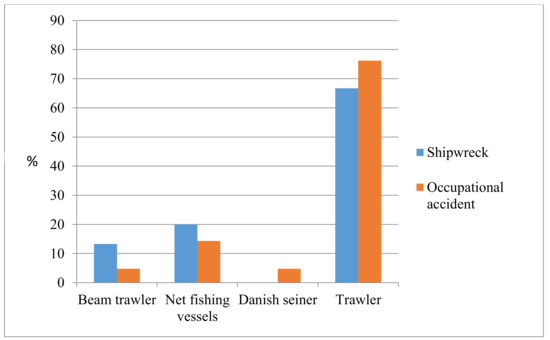
Figure 4.
Distribution of different kinds of fishing vessels involved in shipwrecks and occupational injuries in percentage in the period 1998–2016.
Only 9% of the shipwrecks reported in the study period involved one-man operated vessels. A comparison of the frequencies, however, shows that 50% of the reported maritime shipwrecks involving one-man operated vessels resulted in the death of the fisherman, whereas the corresponding number for multi-man operated vessels is 40% (Figure 5). This study also reveals that most of the reported maritime shipwrecks occurred in the periods between February and May, and September and December.
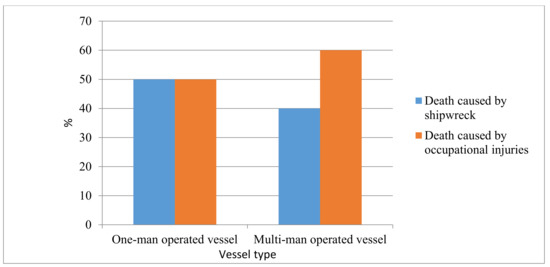
Figure 5.
Distribution of deaths caused by work-related injuries and shipwrecks depending on crew size of the vessel in the period 1998–2012.
3.3. Work-Related Injuries
The data from 1998 to 2016 indicate that most of the reported injuries (81%) happened to fishermen, while 12.8% happened to skippers and 4.4% to fishermen aspirants, which probably is similar to the relative frequency of these three job categories. Table 3 provides distribution of occupational injuries on different types of vessels. Most of the identified work-related accidents (72.1%) have taken place on trawlers.

Table 3.
Distribution of injuries on different types of vessels in the period 1998–2016.
Table 4 shows the percentage of injuries that occurred at different locations on the vessel. It indicates that most of the injuries happened on deck (74.5%) and in the cargo hold (8%).

Table 4.
Location of injuries on the vessels in the period 1998–2016.
Furthermore, looking at the distribution of injuries on different types of vessels as well as the place of the reported injuries, the results of our study showed that most of the injuries occurred on the deck of the trawlers (53%). Irrespective of vessel type, the deck seems to be where the majority of the reported injuries occur (in Table 5).

Table 5.
Distribution and place of reported injuries (in number and percentage) among different types of vessels in the period 1998–2016.
The results showed that most of the injuries (29%) took place between 12:00 and 16:00, and the second largest number of injuries took place between 8:00 and 12:00 (23.3%) (Figure 6). Figure 6 shows the percentage of injuries that occurred on one-man operated vessels and multi-man operated vessels at different times of the day. The results showed significant differences (χ2 = 14,520; p = 0.013) of work-related injuries during the time of the working schedule. In multi-man operated vessels, a greater percentage of work-related injuries occurred between the hours 16:00–04:00, while the one-man operated vessels had a greater proportion of accidents that occurred between the hours 04:00–16:00. Normally, the one-man operated vessels depart for fishing early in the morning, while the larger vessels work at both day and night. Therefore, the rate of injuries presented in Figure 6 is correlated with the timing of sailing and fishing activities.
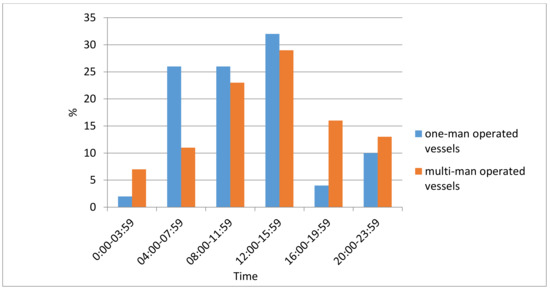
Figure 6.
Crew size and time of work-related injuries in percentage in the period 1998–2012.
This study also revealed that working experience on the fishing vessel might have had an influence on the risk of work-related injuries (Figure 7). More than 52.4% of the reported injuries involved fishermen who have been employed on the vessel less than one year. On the other hand, 31.7% of the reported injuries involved fishermen who have been employed on the vessel between 1 and 5 years.
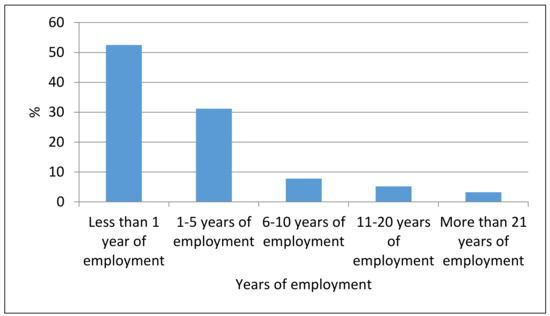
Figure 7.
Length of employment on the fishing vessel at the time of work-related injury in the period 1998–2016.
Table 6 presents the body parts damaged by injuries on the fishing vessels. The results show that damage to the fingers represents 15.1% of the injuries together with shoulder/arm/elbow/wrist. The second largest group of injuries (12.7%) is the back. The other more common injured body parts are leg/knee/hip and thigh accounting for 11.8%, food/ankle/toes 8.9% and neck/head 8.4%.

Table 6.
Injured body parts of fishermen in the period 1998–2016.
The most common work-related injuries were sprains (34.2%), open/closed fractures (24.8%), and wounds (11.1%) (Table 7). Almost one-quarter (23.4%) of the injuries are included in the category “other”. The reason behind this is due to multiple body parts injured at the same time, which cannot be reported in the system as it is only possible to choose one injured body part. The data of this study also provide information on whether the injuries are caused by lifting, slip/fall or crushing. The results show that the percentage of lifting injuries is 6.9% (118), crush injuries is 28.6% (514), and slip/fall injuries represent 29% (514).

Table 7.
Type of injury on fishing vessels in the period 1998–2016.
The results show (Figure 8) that the incidence rate for lifting injuries is relatively low throughout the study period compared to slip/fall and crushing injuries. There has been a reduction in the incident rate of injuries caused by slip/fall or crushing. The incident rate of injuries with slip/fall injuries has decreased from 10.06 per 1000 fishermen in 1998 to 3.84 in 2016. Those changes can be explained by providing the skid proof deck. The incidence rate of injuries caused by crushing has also decreased during the study period, from 9.32 accidents per 1000 fishermen in 1998 to 2.56 in 2016.
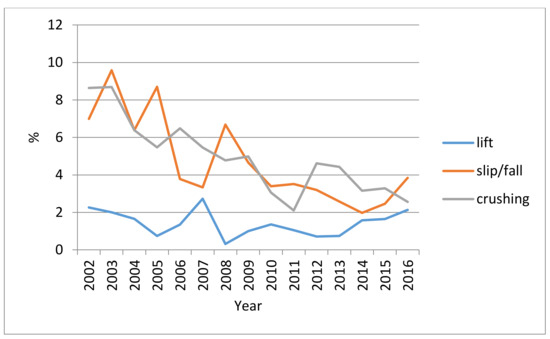
Figure 8.
The rate (per 1000 fisherman) of three types of incidents causing injuries (1998–2016).
4. Discussion and Conclusions
The study has shown that work-related injuries in the Danish fishing industry seem to be the highest in the first 5 years of employment at the fishing vessel, and unfortunately, this remains unchanged throughout the whole study period. Another important finding of this study is that working on a one-man operated vessel is much more risky than multi-person operated vessels as 50% of one-man vessels result in death compared to 40% of multi-man operated vessels.
This research also demonstrates that two types of damages, namely fractures (closed) and sprains, together constitute more than half of the incidents, which causes long-term absences from work. We noticed that collision with other boats, especially with merchant ships, is the main reason for shipwreck, which implies that the navigation route might not be properly followed either by the fishing vessels or the merchant ships. As the number of merchant ships is increasing gradually, intuitively one could expect that there would be a higher risk of collisions between fishing vessels and merchant ships. Collision may occur at any time of the day and the year, but night-time and winter seasons seem to be riskier. So, to ensure the safety of navigation and the safety of fishermen, innovative methods should be developed to avoid and reduce the occurrences of fatal collisions between merchant ships and fishing vessels.
Understanding how humans respond to risk (e.g., physical risk, economic risk) has important implications both for the policy-makers and the fishing industry in designing safety policies and procedures [16]. If the fishermen’s risk tolerance level and the effect of that level on individual decision-making is not considered, unexpected and sometimes undesirable outcomes may occur [17]. Presently, working on the fishing vessels in Denmark is much less exhausting than before as many of the hazardous tasks (for instance hauling the nets, shoveling ice in the hold, and filling of the catch into the hold) on board have now become mechanized [18]. So, without any doubt, the technological development has significantly reduced the rate of injuries in the Danish fishing vessels. Furthermore, the ITQ (Individual Transferable Quota) management system improves sea safety as the fishermen now have more flexibility in choosing when to fish and to avoid fishing in bad weather [19]. The results of interviews from Grøn et al. showed that the interviewed fishermen see ITQ as an improvement of their safety because they try to fish in good weather as far as possible; therefore, there is less needed to sail in bad weather conditions [13]. As mentioned earlier, one of the other elements which influences safety in the Danish fishing industry is the establishment of the Danish Fisherman’s Occupational Health Service (DFOHS). The key tasks of the DFOHS are to consult with the fishermen about safety issues, conduct safety campaigns and inspect the fishing vessels regularly. Therefore, the reduced rate of slip/falls and crushing injuries could be seen as a positive effect of campaigns in combination with use of better equipment. Furthermore, efforts have been made to spread out the use of non-slip boots and slip-resistant surfaces both from (DFOHS) and an intervention project [20]. Another remarkable initiation of the DFOHS on safety issues was to produce a manual on how to manage the stability of smaller fishing vessels. Capsizing of the small vessel (0–15 m length) was one of the major risks in the Danish fishery which caused the death of a number of fishermen. The main cause of capsizing is the instability of the vessel. However, the risk of capsizing can be significantly reduced with some small adjustments to the vessel. The DFOHS has produced a working manual on the stability of a small vessel—giving the captains good and valuable knowledge of the vessel’s stability and how to manage the vessel’s stability to prevent capsizing [21]. That manual has had a positive impact on reducing capsizing of small vessels.
Despite technological interventions and establishment of the DFOHS, in the last couple of years, some other substantial changes have been observed in the Danish fishing industry like safety campaigns, increased awareness about potential risks and legislative changes. Each year, DFOHS produces an annual report [22]. In this report they present their current focus areas, the work carried out during the past year, and the results of their collaborative efforts with DMA and The Danish Maritime Accident Investigation Board (DMAIB) for the improvement of safety onboard. In 2016, at one of the meetings for harbor safety committees, DMAIB declared that they intended to write an investigative report on safety for apprentices on fishing vessels [23]. All these initiatives seem to have a positive effect in reducing the risk of work-related injuries in the Danish fishing industry. Nevertheless, we would like to stress that only compliance with the existing regulations is not enough to achieve safety onboard. In the future, it is important that all the stakeholders should continue focusing on the various elements of safety issues and development of positive attitudes towards safety. There is also a need for a special focus on new crew members by introducing them to the existing safety culture on the fishing vessels and mentoring their works in the beginning to avoid and /prevent occupational injuries, as the results showed that newcomers have a higher level of injuries.
Finally, we would like to indicate that the small trawlers and fishing boats are gradually being replaced by the giant fishing vessels, and this trend indicates that, in future, the capture fishery (especially the trawl fishery) is largely going to be controlled by the big corporations. Due to this corporate strategy, the small-scale fisheries (especially the owner-based fishing vessels) might face challenges regarding surviving in the fishing business as the big companies will have the competitive advantages compared to the small- and medium-sized fishing companies. In contrast, we also believe that industrialization of the capture fisheries could significantly reduce the work-related accidents as the big companies will come forward with more investments, not only to introduce the fishing vessels with innovative technologies and sophisticated devices to reduce the accidents, but also with the effective standards/protocols to ensure the highest level of workplace safety like any other offshore corporations (for example, offshore wind). The big companies will also indirectly force the medium- and small-scale fishing companies to put more emphasis on safety issues and to create the best practices for maintaining a safe workplace in fishing vessels
5. Limitation of the Study
One of the challenges in the quantitative data used in this study is uncertain information on the fishermen population. In this study, we used data on the size of the population from the Danish Ministry of Food, Agriculture and Fisheries [20]. The database does not provide information on the age or experience of the fishermen, which could be useful to conduct in-depth analysis about preventing injuries, and it is also not regularly updated. Another challenge lies in the category “other”, which accounts for a large share of the responses. There is need for a more flexible reporting system where several categories can be ticked off, as today it is only possible to mark a single category.
Author Contributions
Both authors performed all the tasks equally in data analyses and writing of the paper.
Conflicts of Interest
There is no conflict of interest.
References
- McClanahan, T.; Allison, E.H.; Cinner, J.E. Managing fisheries for human and food security. Fish Fish. 2015, 16, 78–103. [Google Scholar] [CrossRef]
- Jensen, O.C. Mortality in Danish Fishermen. Bull. Inst. Marit. Trop. Med. Gdyn. 1996, 47, 5–10. [Google Scholar]
- Kaerlev, L.; Dahl, S.; Nielsen, P.S.; Olsen, J.; Hannerz, H.; Jensen, A. Hospital contacts for chronic diseases among danish seafarers and fishermen: A population-based cohort study. Scand. J. Public Health 2007, 35, 481–489. [Google Scholar] [CrossRef] [PubMed]
- Laursen, L.H.; Hansen, H.L.; Jensen, O.C. Fatal occupational accidents in Danish fishing vessels 1989–2005. Int. J. Inj. Control Saf. Promot. 2008, 15, 109–117. [Google Scholar] [CrossRef] [PubMed]
- Kaerlev, L.; Jensen, A.; Nielsen, P.S.; Olsen, J.; Hannerz, H.; Tuchsen, F. Hospital contacts for injuries and musculoskeletal diseases among seamen and fishermen: A population-based cohort study. BMC Musculoskelet. Disord. 2008, 9, 8. [Google Scholar] [CrossRef] [PubMed]
- Matheson, C.; Morrison, S.; Murphy, E.; Lawrie, T.; Ritchie, L.; Bond, C. The health of fishermen in the catching sector of the fishing industry: A gap analysis. Occup. Med. 2001, 51, 305–311. [Google Scholar] [CrossRef]
- Conway, G.A. Casting their lot upon the water: Commercial fishing safety. Lancet 2002, 360, 503–504. [Google Scholar] [CrossRef]
- Hansen, H.L.; Tuchsen, F.; Hannerz, H. Hospitalizations among seafarers on merchant ships. Occup. Environ. Med. 2005, 62, 145–150. [Google Scholar] [CrossRef] [PubMed]
- Ministeriet for Fødevarer Landbrug og Fiskeri. Fiskeridirektoratets Individregister 2013 [9 December 2013]. Available online: http://webfd.fd.dk/stat/aldersstatistik/bi_og_erh_fiskere2012.html (accessed on 22 November 2017).
- Danish Agrifish Agency. Commercial Fisheries [29 February 2016]. Available online: http://agrifish.dk/fisheries/commercial-fisheries/ (accessed on 28 October 2017).
- Eurofish. Overview of the Danish Fisheries and Aquaculture Sector. Available online: http://www.eurofish.dk/denmark (accessed on 29 March 2018).
- Jensen, O.C. Work related injuries in Danish fishermen. Occup. Med. 1996, 46, 414–420. [Google Scholar] [CrossRef]
- Grøn, S.; Rasmussen, H.B.; Poulsen, T.R.; Christiansen, F.N. Safety in the Fishing Industry [19 January 2015]. Available online: http://www.bsac.dk/archive/Dokumenter/Flagship%20Project/Safety%20in%20the%20Danish%20fishery.pdf (accessed on 29 March 2018).
- Danish Maritime Authority. Safety at Sea. Available online: https://www.dma.dk/SikkerhedTilSoes/Sider/default.aspx (accessed on 15 December 2017).
- McGuinness, E.; Aasjord, H.L.; Utne, I.B.; Holmen, I.M. Injuries in the commercial fishing fleet of Norway 2000–2011. Saf. Sci. 2013, 57, 82–99. [Google Scholar] [CrossRef]
- Holland, D.S. Are fishermen rational? A fishing expedition. Mar. Res. Econ. 2008, 23, 325–344. [Google Scholar] [CrossRef]
- Smith, M.D.; Wilen, J.E. Heterogeneous and correlated risk preferences in commercial fishermen: The perfect storm dilemma. J. Risk Uncertain. 2005, 31, 53–71. [Google Scholar] [CrossRef]
- Breidahl, T.; Christensen, M.; Jepsen, J.R.; Johansen, J.; Omland, O. The influence of ship movements on the energy expenditure of fishermen. A study during a North Sea voyage in calm weather. Int. Marit. Health 2013, 64, 114–120. [Google Scholar] [PubMed]
- Emery, T.; Hartmann, K.; Green, B.; Gardner, C.; Tisdell, J. Fishing for revenue: How leasing quota can be hazardous to your health. ICES J. Mar. Sci. 2014, 71, 2650–2662. [Google Scholar] [CrossRef]
- Jensen, O.; Laursen, L.H.; Knudsen, F. Vurdering af Effekten af Skridsikre Støvler og Skrid-sikkert Dæk i Fiskeri; Arbejds-og Maritimmedicinsk Publikationsserie: Esbjerg, Denmark, July 2008. [Google Scholar]
- DFOHS. Stability Guide for Smaller Vessels. 2014. Available online: https://www.dma.dk/Vaekst/EU/EUOestersoestrategi/PAsafe/Notifications%20PA%20Safe/Stability%20Guide%20for%20Smaller%20Vessels%20by%20Danish%20Fishermen%27s%20Occupational%20Health%20Services.pdf (accessed on 14 March 2018).
- DFOHS. Årsberatning 2016 (Annual Report 2016). 2016. Available online: https://www.f-a.dk/wp-content/uploads/2015/01/F-A-aarsberetning_2016.pdf (accessed on 14 March 2018).
- Danish Ministry of Food, Agriculture and Fisheries. Operational Programme for Development of the Danish Fisheries and Aquaculture Sector 2007–2013 [9 January 2015]. Available online: http://naturerhverv.dk/fileadmin/user_upload/NaturErhverv/Filer/Tilskud/Projekttilskud/Fiskeriudvikling/Fiskeriudviklingsprogram_2007-2013.pdf (accessed on 15 December 2017).
© 2018 by the authors. Licensee MDPI, Basel, Switzerland. This article is an open access article distributed under the terms and conditions of the Creative Commons Attribution (CC BY) license (http://creativecommons.org/licenses/by/4.0/).